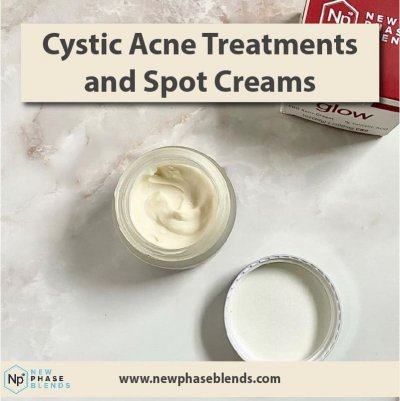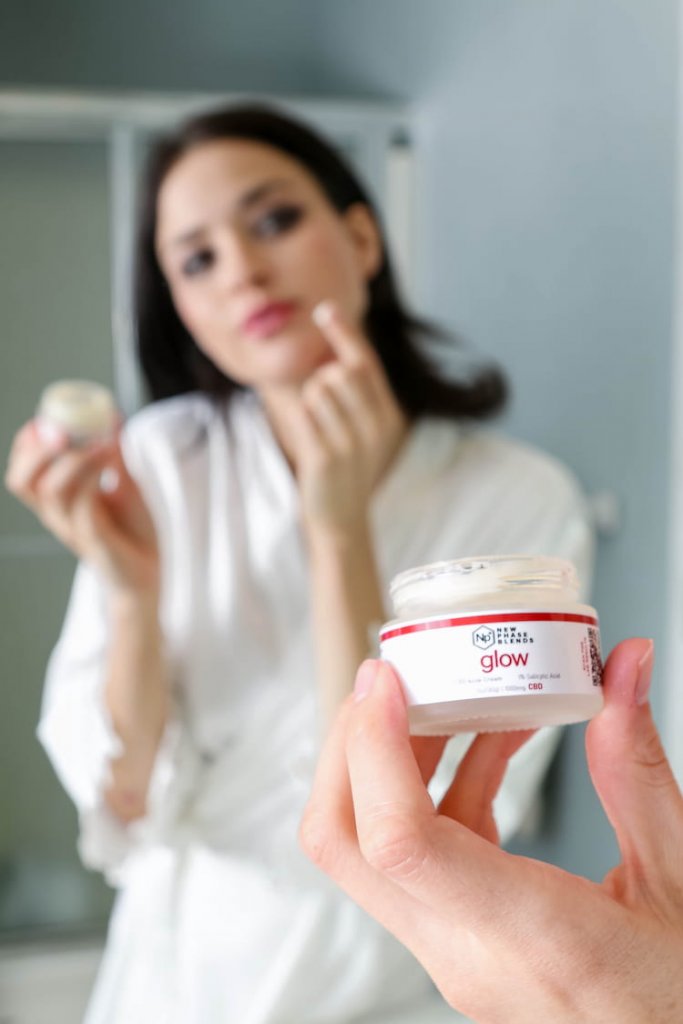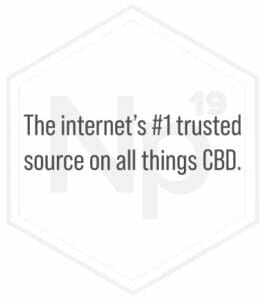Curious about cystic acne treatment techniques that actually work? What about using CBD for sebaceous cyst relief? Do cystic acne spot treatment creams exit that might help?
Well, you’re going to love this article!
Have you ever experienced going to sleep with a nice, clear face and then getting up with swollen zits on your face? Not the best surprise, is it? This is annoying, to say the least!
The first thing that comes to mind is usually, “Oh my God, how can I get rid of this as quickly as possible?”
How about having an important business engagement, or date. No one wants to have all eyes on them when their skin looks, well, bad. While you might be able to rub some cystic acne cream on your face and call it good, studies suggest that most cystic acne cream doesn’t work that well.
Don’t worry, though. This article contains all you need to know about how a cystic acne spot treatment might help, and cystic acne treatment options with the use of a special product that uses CBD and salicylic acid.
Cystic Acne: A Horrible Experience for All
Once zits appear, it usually takes more time than we want for them to go away. The Mayo Clinic has declared cystic acne as a more serious form of acne that sprouts its roots deep below the skin.
Cystic acne can be super sore and results in significant, red, swelling and constant pain that surrounds the area.
What causes cystic acne is important to know. The main reasons for cystic acne development are:
- excessive sebum secretion
- production of bacteria into the pores
- dead skin cells clogging the pores
Cystic acne, to some extent, looks like boils and is typically extremely painful if touched. Furthermore, this type of acne usually occurs on the face, neck, shoulders, back, and arms. It is usually the form of acne that leaves little divots in the skin than result in severe scarring.
A good cystic acne spot treatment will clear the acne before it is able to leave these divots.
Related Article: Remedies to Help Get Rid of Acne Scars
Whatever product you end up using, just remember the cystic acne spot treatment must be extremely effective at both clearing the pore, and healing the affected area.
What good is a spot treatment that clears up an area, but leaves it red and swollen for days? We’re all looking to get rid of that redness as soon as humanly possible, am I right?
Cystic acne is more common in people with oily skin and is usually found in teens, women, and older adults with hormonal imbalances.
If you think you may be suffering from cystic acne, you need to consult a dermatologist for the best possible advice in regards to both the cause of your issues, and the best things to use as a cystic acne spot treatment.
New Phase Blends has a product called ‘glow’ that can treat skin issues like this, but nothing compares to having a one-on-one consult with a dermatologist. Prescription medications may be necessary.
 At New Phase Blends, we create products to help people not need to rely on prescription drugs, however, there is nothing wrong with taken them as needed. Some people require them, and some do not – there is nothing wrong with that!
At New Phase Blends, we create products to help people not need to rely on prescription drugs, however, there is nothing wrong with taken them as needed. Some people require them, and some do not – there is nothing wrong with that!
For your best defense against cystic acne or sebaceous cysts, we have compiled a list of a few home remedies to help clear your skin up as quickly and safely as possible. These remedies can ease the condition of the skin and diminish the severity of your skin troubles.
So, let’s get started!
How To Identify Cystic Acne or Sebaceous Cysts
It is very important to identify the type of acne you may have in order to best develop a plan to clear your skin.
Cystic Acne
Cystic acne is the most severe form of acne that can result in extreme pain and redness. Unlike other acne types that remain on the top of the skin surface, cystic acne resembles the boils, and roots deeper below the skin.
Since this type of acne can be quite severe, a powerful cystic acne spot treatment is normally required.
Redness, large pus-filled cysts, large white bumps, or being painful to the touch are few other identifiable cystic acne symptoms.
The area on our bodies that are more likely to develop cystic acne include the face, chest, neck, back, arms, shoulders, and even armpits.
At the same time, the face is the most noticeable area with cystic acne. Most people can manage this by applying a cystic acne spot treatment on their back and shoulders. The spot treatments can also be applied to the face, but you can’t really cover up your face and hide the acne like you can for your back or shoulders.
For this reason, we all want something that works fast, and well.
Sebaceous Cysts
Cysts, generally speaking, are simply spots in the body (typically swollen in appearance) that may have a liquid or gel-like substance inside of them. Sebaceous cysts are more likely to be found on the skin of the neck, face, or upper body.
hey aren’t necessarily dangerous, and they grow quite slow when compared to other forms of cysts.
While not life-threatening, you should be sure to have them checked on periodically. Some people prefer to have them removed, some people prefer to leave them alone – it all depends on the size, location, and severity of the sebaceous cyst.

Photo Source: WebMD
As you can see in the picture above, sebaceous cysts can be large, but they aren’t accompanied by the unfortunate redness that covers the area of cystic acne.
Sebaceous cysts will sometimes require a different approach than a cystic acne spot treatment can offer. Dermatologists may need to remove the cyst themselves.
Have you heard of Dr. Pimple Popper? She actually built a booming business on airing some of her sebaceous cyst removals.
Cystic Acne Treatment: Over the Counter Creams
The following home-based remedies are generally safe to treat cystic acne, however, before trying these remedies, consult with your dermatologist.
They will offer you medical advice that we cannot otherwise offer on this website. Also, please remember that CBD products are not approved by the FDA as a dietary supplement, yet.
The statements or products contained on this website are not meant to diagnose, treat, prevent, or cure any form of disease or skin conditions.
Now, let’s find out how to get rid of cystic acne, or at least minimize the appearance of it.
CBD Oil & CBD Products for Cystic Acne Treatment
Cannabidiol, also known as CBD, is getting hype and becoming famous for its pain-relieving and anti-inflammatory properties. CBD has been found as the best natural source for treating acne and other skin problems more naturally.
Related Article: Does Using CBD for Acne Work?
However, CBD alone isn’t the best approach to treating cystic acne or sebaceous cysts. While CBD may, in fact, aid in reducing inflammation and swelling that is often associated with breakouts, it cannot clean your pores out.
New Phase Blends developed a product called ‘glow’ that utilizes a 1% salicylic acid base, in addition to tea tree oil and CBD-rich hemp extract. All of these together help trigger a powerful two-staged acne fighting product when applied directly to the skin.
While the salicylic acid beings to clear out the pores and surrounding area, the CBD-rich hemp extract reduces redness and swelling. Remember, the worst part about most cystic acne spot treatments is they don’t address the redness and swelling.
We’ve fixed that problem.
You can apply the CBD products topically as a cystic acne treatment to get some relief from the pain and swelling.
Plus, CBD topicals such as creams, balms, and lotions are readily available for direct skin application. CBD drops, or CBD tinctures, are also a good product to use to help take the edge off the pain and swelling associated with cystic acne or other forms of skin issues.
Related Article: What is the Best Method to Use CBD?
Cystic acne cream, like ‘glow’, can be a great approach to helping get your skin looking nice and healthy again.
Ice Cubes
Ice has soothing effects for swollen and itchy skin.
It helps in decreasing swelling, pain, itchiness, and redness on any area of the skin. Ice is often useful in diminishing the severity of cystic acne. Rubbing the ice cube almost three times a day on cystic acne decreases the swelling and relieves the pain.
Ice cubes, while soothing, are only a very temporary approach to cystic acne treatment, and are perhaps the weakest form of a cystic acne spot treatment.
Aspirin Mask
An aspirin mask can help to reduce the inflammation and pain caused by cystic acne. A few home remedies have suggested using the mixture of crushed aspirin powder and water on cystic acne. The application of this mild, thick paste acts as a type of cystic acne spot treatment.
What, exactly, is an aspirin mask? It’s a thick, pasty-type substance that is made with crushed up aspirin and small amounts of luke-warm water. The water should be warm, at a minimum, to promote opening of the pores. This allows the aspirin mask to penetrate your skin as deeply as possible.
The company Popsugar has a pretty good article on making the best aspirin mask. Check it out here.
This remedy is not for every skin type because few people have a known allergy to salicylates (contained in aspirin products).
Direct application of aspirin on the skin can irritate it so, please double check with your doctor or dermatologist before trying this.
Balanced Diet
People in favor of natural remedies for cystic acne treatment have suggested keeping a strict check on their diet routine. Dairy and dairy-based items can help develop cystic acne (in some people).
To treat the cystic acne, you may need to avoid dairy items, including milk, yogurt, cheese, and butter, for at least three to four weeks to give your skin a bit of relief.
If there is no new cystic acne eruption, that means dairy could have very well been the cause of your skin trouble.
Also, excessive use of sugar, oil, and processed food can trigger cystic acne breakouts. Focus on a healthy diet plan rich in fiber, protein, and vitamins/minerals.
A great cystic acne treatment will encompass many different things, including a balanced diet.
Turmeric Mask
This readily available kitchen item, turmeric, is a natural solution to many skin problems, including getting rid of cystic acne. It is full of anti-inflammatory and antiseptic properties that can help decrease the severity of cystic acne.
Apply small amounts of turmeric powder mixed with warm water and directly apply it to the cystic acne. Let it penetrate the skin for 45 minutes or so and then rinse it off. Apply this paste two times a day for better results.
Take care while applying it directly on the skin as it can irritate sensitive skin. Just like with the aspirin mask, make sure the water is warm to help open the pores. This lets the pores absorb even more of the turmeric.
Vinegar Cleanser
Apple cider vinegar is an excellent natural remedy to get rid of cystic acne. It has anti-bacterial properties that help to remove the bacteria and dead skin cells from the skin.
Some proponents of natural healing remedies have suggested using a diluted white vinegar cleanser two times a day.
Be careful when applying a vinegar and water solution, as it can irritate your skin. Also, avoid the direct application of vinegar on the face. A good ratio of vinegar to water is two capfuls of vinegar and three cups of filtered, clean water.
Probiotics
The daily dose of probiotics encourages both skin health and gut health. Probiotics decrease skin inflammation and can lead to a much more clear and healthy skin. A good approach to cystic acne treatment might involve the use of these healthy probiotics.
Add a great source of probiotics such as yogurt, kimchi, vegetables, kefir, and other foods containing beneficial bacteria and help regain skin health. There are also probiotics available in pill form.
While probiotics aren’t a good cystic acne spot treatment, since they must be digested in the gut, they do help clear up your skin indirectly.
Tea Tree Oil
Tea tree oil is a a natural solution to soothing the skin and also promotes skin health. It contains antimicrobial and anti-inflammatory properties that make it an excellent option for treating and preventing cystic acne.
As with any other oil, be careful with potentially getting your skin too oily. Some people are ok with oil-based facial products, some are not. Everyone’s skin is a little bit different and reacts to different products…differently.
What Are The Medical Cystic Acne Treatment Options?
Home remedies for cystic acne treatment or sebaceous cysts should be the first choice for safe treatment, however, it tends to be time-consuming.
These choices may not be potent enough to treat cystic acne. Remember when I mentioned earlier that some people may end up needing a prescription approach for their skin problems? Some of the medical treatments for severe cystic acne or sebaceous cysts may include:
- azelaic acid (Azelex)
- isotretinoin (Accutane)
- oral antibiotics (tetracycline)
- dapsone (Aczone)
- spironolactone (Aldactone)
- topical retinoids (Retin-A)
- Light-based therapy (laser or photodynamic)
- steroid injections into cystic and nodular wounds.
*Consult with your dermatologist before undergoing any medical treatments.
Conclusion | Cystic Acne Treatment
Undoubtedly, natural healing options are a good first step in a good cystic acne treatment regimen.
This can sometimes be done with easy methods as mentioned above. Other times, it requires the use of a cystic acne spot treatment, similar to glow.
Remember, the most important factor in cystic acne treatment is finding a product that not only cleans and clears out your skin, but corrects the redness and swelling too. Many products on the market can clean the skin, but they leave it dry and red.
We don’t want this.

Give our cystic acne cream products a try, and don’t be scared or ashamed to consult a dermatologist for extra help if needed. That’s what they are there for!
Finally, if you aren’t pleased with our products (any of them) please return them within 30 days of the original purchase for your money back – all of it. We want you to love our products – nothing less.
References
Cleveland Clinic: https://my.clevelandclinic.org/health/diseases/14165-sebaceous-cysts
Leafly: https://www.leafly.com/news/cbd/cbd-for-inflammation-science
Mayo Clinic: https://www.mayoclinic.org/diseases-conditions/epidermoid-cysts/symptoms-causes/syc-20352701, https://www.mayoclinic.org/diseases-conditions/acne/symptoms-causes/syc-20368047
Popsugar: https://www.popsugar.com/beauty/How-Use-Aspirin-Mask-Acne-1140069


















